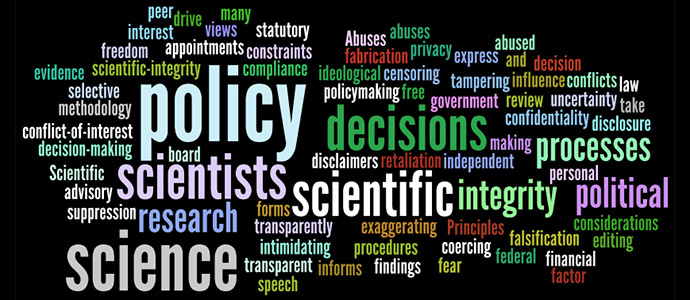Fostering Scientific Integrity in Policymaking: Opportunities at the State Levelby Matthew Druckenmiller |
| The CSTPR blog, Prometheus, was revived in 2016 to regularly feature content from CSTPR core faculty, research associates, postdocs, visitors, students and affiliates to serve as a resource for science and technology decision makers. This new dynamism reflects the new energies and pursuits taking place in and around CSTPR. Below we feature one of the recent Prometheus blog posts. |
|
Scientific integrity is the foundation for science and scientists to be useful to, and trusted by, those consulting science to make decisions. The Union of Concerned Scientists (UCS) defines scientific integrity as “processes in which independent science fully and transparently informs policy decisions, free from inappropriate political, ideological, financial, or other undue influence”. In today’s climate of divided politics, partisan rancor, and rampant spread and availability of misinformation, efforts are underway to safeguard what UCS defines as the four principles of scientific integrity in federal policymaking: (1) independent science, (2) scientific free speech, (3) transparent decision making, and (4) statutory compliance. The first two are at the core of what it means to be a scientist. By and large, scientists commit to the deeply held belief that their work must be free from conflicts of interest that may bias their science, and that they are free to express their personal views on the science with appropriate disclaimers. The third and fourth principles, however, are perhaps more in-view for those scientists working at the interface of science and policy; those immediately concerned with bringing science in service of the public good. (While the proportion of basic research funded by taxpayer dollars is dramatically down from previous decades, federal funds remain by far the largest supporter of research.) Implementing statutory compliance to scientific integrity refers to legal frameworks that require that the best available science be brought to bear on policy decisions. Knowing where and how such frameworks apply requires experience, and is key to identifying opportunities for bringing transparent, independent science to bear on federal policy deliberations. However, any momentum toward greater evidence-based governance in the U.S. and action on some of the most pressing issues we face requires progress at the state level as well. Policy issues debated in a federal context often mirror discussions underway across the states, whether, for example, related to health-care, education, environment, or extreme weather events. Also, in terms of opportunity, it is important to keep in mind that the vast majority of states (if not all) are not experiencing the gridlock of the U.S. Congress. (For example, in Colorado, 62% of bills introduced last year passed both chambers, and were passed onto the Governor. By comparison, the 114th U.S. Congress sent only about 3% of introduced bills to the President.) While there are some nonpartisan resources at state legislators’ disposal, most states lack adequate resources to support informed legislative policy. Yet, they are encountering issues that are increasingly technically complex without the scientific or technical expertise to address them. One partial solution is to bring more scientists into the policy realm. Towards this goal, the Center for Science and Technology Policy is currently exploring the creation of a science and technology policy fellowship program at the state level. What would such a program look like? Ideally, the fellowship would entail 1-2 year placements of PhD-level scientists and professional engineers within the state legislature to provide an in-house source of non-partisan, evidence-based information. In other words, the program will embed a “scientist’s mindset” into the daily activities of the legislature. In turn, these fellowships will expose scientists to the policymaking process and to opportunities (statutory or otherwise) for science and evidence-based information to be considered in the context of critical issues facing the state, including water resources, transportation, wildfire management, agriculture, air quality, and resource development—issues that are intricately linked to the state’s dramatic population growth and economic development. Of course, this is not a new idea! The American Association for the Advancement of Science (AAAS) has implemented an S&T policy fellowship program at the federal level since 1973, and now places approximately 300 fellows each year in all branches of the federal government. At the state level, the California Council on Science and Technology (CCST) has implemented a successful program within the California Legislature since 2009, and places up to 10 fellows per year. Both of these programs provide a wealth of experience for efforts that are now underway to plan similar fellowships in nine states across the country, including Colorado. A decade ago, the state science and technology policy movement was seen as somewhat uncharted territory. However, those interested in science and technology recognized that many of the institutions needed to inject scientific considerations into state policymaking already existed, but that the potential was largely unrealized. This report by the National Academy of Sciences summarizes the first of its kind convocation that took place in 2007 to discuss with state policymakers the benefits of policy informed by science and technology. The report outlines opportunities and challenges, and called for a mechanism for sharing best practices across institutions that are in a position to offer science and technology advice at the state level. The effort underway to plan S&T policy fellowships across states (thanks to the Moore Foundation, the Simons Foundation, and CCST) is an excellent example of such a mechanism emerging. Matthew Druckenmiller, druckenmiller@nsidc.org |


